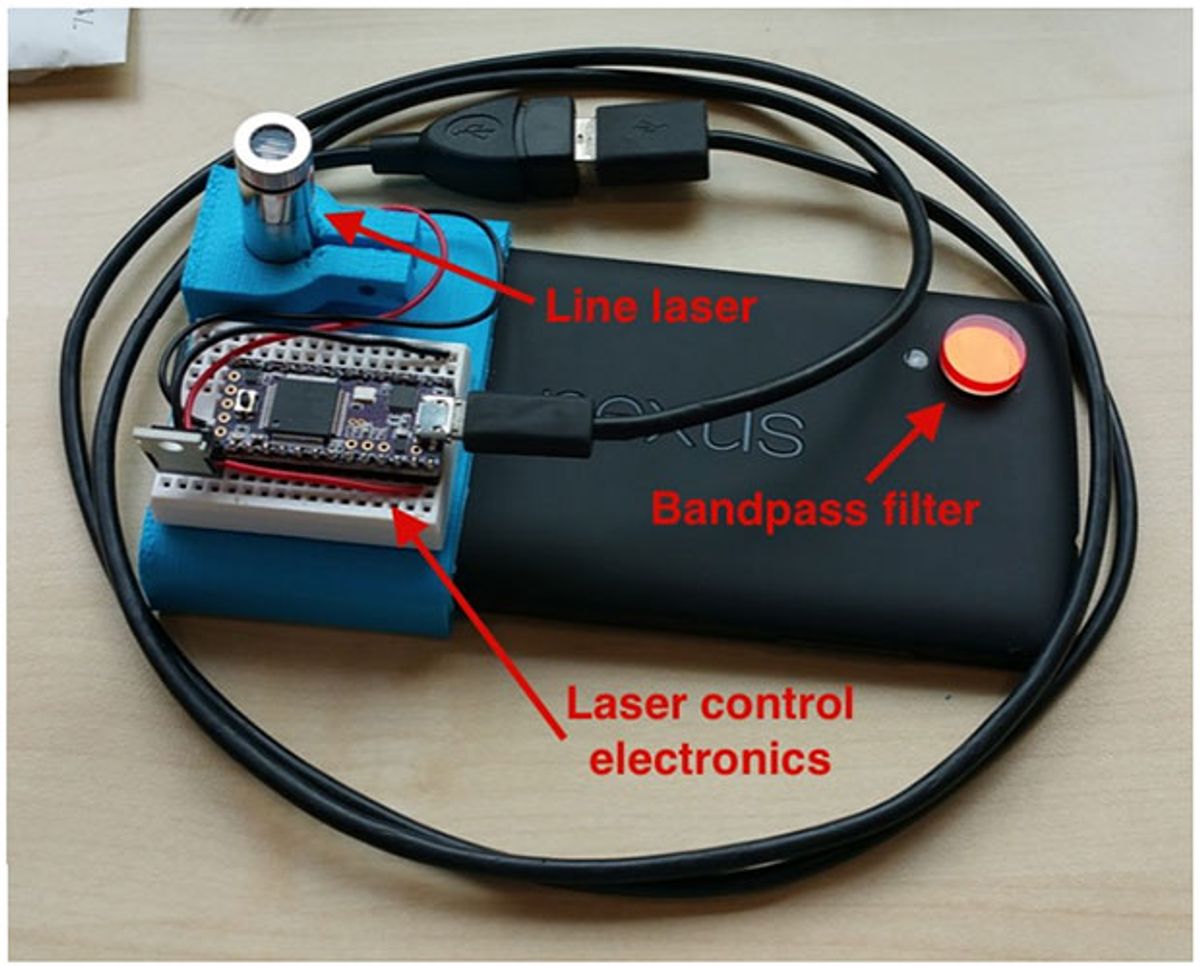To do capable and useful things, your robot needs capable and useful sensors, which is just another way of saying that your robot needs you to spend a lot of money on it. This is really too bad, because hardware cost is enormously restrictive for robots, especially ones that are intended to be affordable by people who haven’t co-founded a robotics startup or something (I think there are a few people left who have yet to do this). In particular, distance sensors that allow your robot to detect and avoid obstacles tend to be both very useful and very expensive, but if you want one that works reliably outdoors, start saving, because they cost thousands of dollars.
At MIT, a group of researchers led by Professor Li-Shiuan Peh designed a phone-based laser rangefinder that costs a total of $49, plus a smartphone that you’re not using anymore. Is it the greatest laser rangefinder ever? Not even close. But for less than $50, it’s pretty darn great anyway.
If you want a low-cost, several meter-range distance sensor for your robot, you have two (soon perhaps three) options right now: a Kinect or a Revo LDS (which is what you get if you rip open a Neato robotic vacuum and pry out its revolving laser distance sensor). Both of these systems are cheap(ish) and work pretty well indoors, but out in the sunlight, they tend to go blind very quickly. The fundamental problem is that these sensors both use active lighting (structured light or a laser), and their sensors can’t distinguish the light that they’re looking for from ambient light if it’s too bright out.
MIT has developed a phone-based laser rangefinder (called “Smartphone LDS”) that solves this outdoor issue by leveraging the power of a smartphone camera to compensate for ambient light:
Smartphone LDS is literally a laser and a filter taped to a Nexus 5 smartphone (sold separately) with some control electronics in the middle. The basic principle of operation is active triangulation: the laser emits light in a horizontal beam, which bounces off of objects and then is captured by the phone’s camera sensor in different vertical positions depending on the distance to the object. By analyzing the angle of the reflected light, the distance to the object can be calculated.

This active triangulation method is also used by the Revo LDS, although Smartphone LDS has the advantage of being completely solid state (no spinny things) combined with the disadvantage of a field of view of about 48 degrees as opposed to nearly 360. The real distinguishing feature, though, is Smartphone LDS’ ability to operate outside in sunlight. The Revo LDS (which, to be fair, was never intended for outdoor use) stops usefully detecting obstacles at distances of above about half a meter in direct sunlight. Smartphone LDS is good to about 2 meters, or nearly 6 meters out of direct sunlight. It’s accurate, too, with just 6 cm of error at 5 meters.
The way Smartphone LDS deals with direct sunlight is through the smartphone camera, and it’s a simple process: the camera spends half of its time just looking for the infrared laser signal, and the other half of its time taking regular pictures. The smartphone’s CPU and GPU perform image processing to subtract out the data in the pictures from the data in the frames containing the laser signal, allowing Smartphone LDS to work even in bright sunlight.
In practice, the MIT reserachers found that Smartphone LDS operates quickly and reliably enough to act as an obstacle avoidance system for vehicles traveling at speeds of up to 18.5 km/h. Most of the limitations in performance come from the smartphone hardware: as much as many people love the Nexus 5, it’s not the newest smartphone on the block, and advances in camera technology (like higher frame rates, high dynamic range, or access to a global shutter instead of a rolling shutter) could significantly improve the range and accuracy of Smartphone LDS. Even just using a modern smartphone processor could theoretically double both the range and accuracy of Smartphone LDS.
This, really, is why Smartphone LDS is so exciting: it’s not just because of what the system can do now—it’s because the performance of the system scales with smartphone hardware, which is getting better and better without anyone in the robotics community having to do anything. Need a better Smartphone LDS? Just wait a few months, or maybe a year, and the newest phone will upgrade your sensor at a very affordable cost as long as your lab is willing to get locked into a new two-year contract from a shady service provider.
We should also mention that the rest of the hardware is only $49 because that’s what the MIT researchers paid for it off the shelf; if something like this were to be mass produced, it’s likely that the cost would drop like a hot potato being held by someone who doesn’t like holding hot potatoes.
“A Smartphone-Based Laser Distance Sensor for Outdoor Environments,” by Jason H. Gao and Li-Shiuan Peh from MIT, will be presented at ICRA 2016 in Stockholm in May.
Via [ MIT ]
Evan Ackerman is a senior editor at IEEE Spectrum. Since 2007, he has written over 6,000 articles on robotics and technology. He has a degree in Martian geology and is excellent at playing bagpipes.




